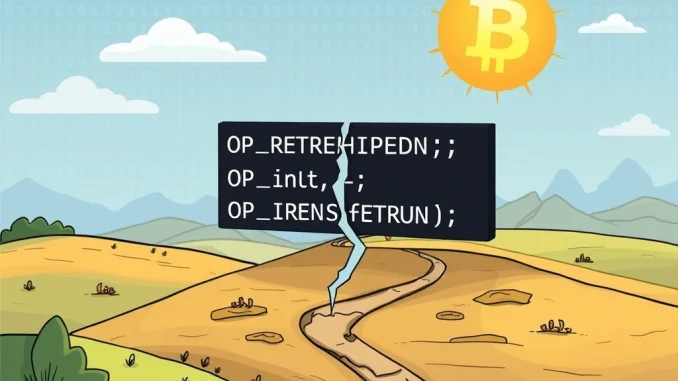
A significant discussion is unfolding within the Bitcoin ecosystem. At the heart of it is a proposal from Bitcoin Core developers regarding the Bitcoin OP_RETURN limit – specifically, the long-standing 80-byte size restriction on data embedded in transaction outputs. This isn’t just a technical tweak; it’s a change sparking considerable debate among developers, miners, and prominent figures in the community.
What is the Bitcoin OP_RETURN Limit Proposal?
Bitcoin transactions typically move value from one address to another. However, a special script type called OP_RETURN allows users to add a small amount of arbitrary data to a transaction output. Think of it like attaching a small note to a payment. For years, this data has been capped at 80 bytes. The core idea behind the current proposal is to remove this Bitcoin OP_RETURN limit entirely in a future software release.
Why do the Bitcoin developers want to do this? Their primary arguments center on efficiency and simplifying the protocol:
- Ineffectiveness: Developers argue the current 80-byte limit is easily circumvented. Users who want to store more data simply create multiple OP_RETURN outputs or use other, less efficient methods.
- Encouraging Workarounds: These workarounds often involve creating numerous small transaction outputs (known as dust outputs) which contribute to bloating the UTXO (Unspent Transaction Output) set.
- Reducing UTXO Set Bloat: By removing the limit, developers hope users will consolidate data into fewer, larger OP_RETURN outputs, potentially reducing the overall number of dust outputs and helping manage the size of the UTXO set, which full nodes must track.
- Simplifying Protocol Rules: Removing an arbitrary limit simplifies the code and rules governing transactions.
The OP_RETURN Debate: Community Concerns Surface
While the proposal aims to address technical debt and improve efficiency, it has ignited a considerable OP_RETURN debate. Critics express concerns that removing the limit could open the door to increased network spam and potential misuse of the blockchain for non-financial data storage on a larger scale than currently possible.
Prominent voices have weighed in:
- Samson Mow (CEO of JAN3): Argues that the change lacks broad consensus within the community, suggesting it’s being pushed forward without sufficient agreement.
- Marty Bent (Ten31 Fund): Expresses concerns that removing the limit could lead to increased ‘spam’ or irrelevant data being permanently embedded on the blockchain, potentially impacting node operators and the network’s primary function as a monetary network.
The core of the opposition’s argument is that while the current limit might be imperfect, its removal could lead to unforeseen consequences, particularly related to the cost and resources required for running full nodes if the blockchain is used more extensively for data storage beyond transaction-related purposes.
Understanding the UTXO Set and Its Importance
The UTXO set is a critical concept in Bitcoin. It represents all the unspent outputs from every transaction ever made. Essentially, it’s the current state of who owns which bitcoins. Every full node on the Bitcoin network must keep track of the UTXO set to validate new transactions. A larger UTXO set requires more memory and processing power for nodes, potentially increasing the barrier to entry for running a full node. Developers are constantly looking for ways to manage its growth, and the Bitcoin proposal to change the OP_RETURN limit is partly motivated by this goal.
What’s Next for the Bitcoin Proposal?
As of now, the proposal is still in the discussion phase. There is no set release date for any software update that would include this change. The debate highlights the careful and often contentious nature of making changes to the core Bitcoin protocol. Any significant alteration requires thorough review, testing, and ideally, broad consensus among developers, miners, and the wider community to maintain the network’s stability and decentralized nature.
The outcome of this OP_RETURN debate will be important to watch, as it touches upon fundamental questions about how Bitcoin should be used and the technical trade-offs involved in managing its growth and efficiency.
Summary
Bitcoin developers have proposed removing the 80-byte Bitcoin OP_RETURN limit, aiming to improve efficiency and manage the UTXO set. However, this Bitcoin proposal has sparked a significant OP_RETURN debate, with critics raising concerns about potential network spam and the lack of community consensus. The discussion involves technical considerations about workarounds and dust outputs versus philosophical arguments about the blockchain’s purpose. As Bitcoin developers continue to refine the protocol, community feedback remains a vital part of the process, shaping the future direction of the network.



